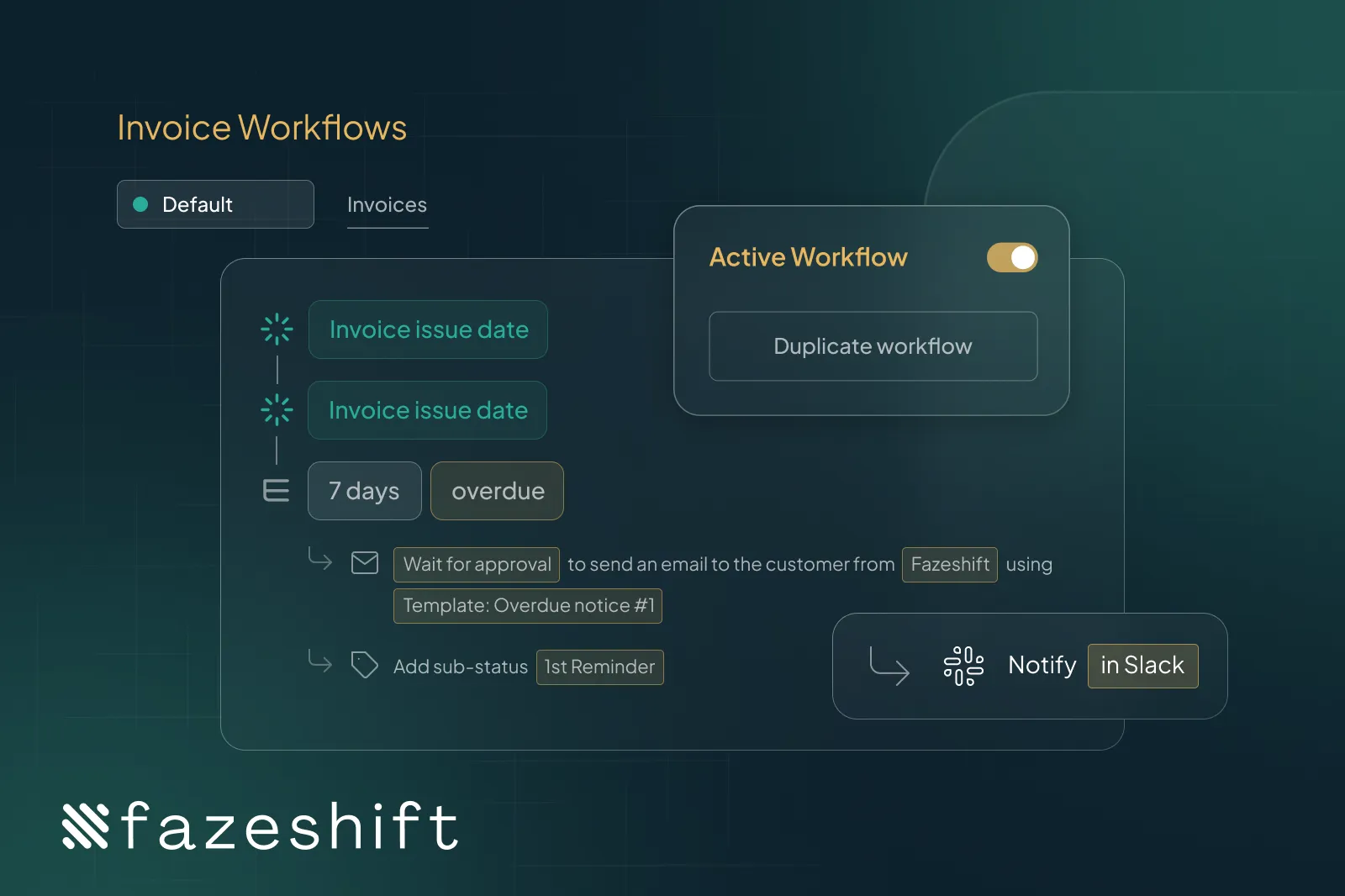How to Avoid and Identify Operational Risks in Accounts Receivable





Managing credit and collecting payments from customers are critical functions for maintaining a healthy cash flow.
Without proper oversight, overdue invoices can quickly get ahead of your team, create an overwhelming backlog, and jeopardize your organization’s cash flow position.
One of the most effective strategies to identify and manage high-risk accounts early are the rules of 10, a pair of best practices used by credit and accounts receivable teams to minimize risk and create a well-oiled collections process.
In this blog post, we’ll explain how the 10-percent cross-aging rule and the 10-day collections benchmark can help finance teams make smarter credit decisions and accelerate cash flow, especially when they’re supported by automation tools like Fazeshift.
Without clear visibility into which customers have significantly overdue invoice balances, you risk extending credit to financially unstable accounts, which can ultimately lead to mounting bad debt and cash flow disruptions for your organization.
The 10 percent cross-aging rule is primarily used by credit managers and lenders during the credit assessment process to identify potentially risky customer accounts early by flagging those with significant overdue receivables.
Cross aging, to be sure, is determined by comparing the monetary amount of overdue invoices to the amount due for all outstanding invoices. When more than a certain percentage of a customer’s account balance is past due, the entire account is considered to be cross aged.
Companies often have their own formulas to determine whether a customer account should be classified as cross aged, but one conservative and ambitious best practice is known as the 10-percent rule.
Under this rule, all of a customer’s outstanding receivables can be classified as high risk or doubtful, if more than 10 percent of their total receivables are overdue beyond a certain period — in most cases, it’s 90 days.
Some organizations provide a little more leeway and permit 25 percent of all receivables to be more than 90 days overdue.
In either of these cases, accounts receivable teams can opt to increase allowances for doubtful accounts, downgrade their creditworthiness, tighten credit terms, or even pull the breaks on new purchases from a customer, if they exceed their allowance for overdue invoices.
If this cross-aging rule is used for a potential customer who has significant outstanding invoice balances with other companies, there’s a possibility that they may be rejected, subject to certain credit restrictions, or required to provide additional collateral.
In practice, the cross-aging rule is designed to help companies detect potential problem accounts early on and proactively communicate with customers when they fall behind on payments. When a customer’s payments are significantly overdue, it may be an early warning sign of financial distress and warrant further review.

Incorporating automation into your accounts receivable workflows can help you get ahead of overdue receivables, improve cash flow, and prevent customers from falling behind on payments in the first place.
Starting with your very first interactions with a potential customer, Fazeshift’s AI credit agent can automatically pull up a credit report on them and provide your team with some recommended actions for approval. You can also skip the approval process and allow the AI credit agent to analyze a customer’s credit report data and automatically set credit limits for them in your organization’s enterprise resource planning system, such as NetSuite and Microsoft Dynamics 365.
Once a contract is signed, Fazeshift can automatically turn it into an invoice and send it out using customizable automation workflows, which can be leveraged to schedule personalized payment reminders or dunning letters at certain periods of time.
Fazeshift even gives you a bird’s-eye view of your aging schedule to keep track of how much of your receivables are past due, how overdue they are, and which customers fall into specific overdue categories.
While it’s not set in stone, a common best practice and benchmark for collecting payments from customers is often known as the rule of 10 in accounts receivable.
Under this principle, the goal for your team would be to collect 10 percent of all outstanding receivables within 10 days after an invoice is sent out.
Though a bit conservative in practice, the rule of 10 places an emphasis on proactive invoicing and payment reminder best practices to improve cash flow, aggressively reduce overdue amounts, get ahead of collection backlogs, and reduce bad debt risks.
Leveraging Fazeshift’s AI agents to automate your invoicing and payment reminder processes will help you waste no time and address slow payers quickly.
In addition to sending payment reminders and dunning letters, Fazeshift can automate responses and attach any documents they request, such as copies of invoices and contracts. Fazeshift’s email AI agent will also flag emails for manual review if it detects something that may require manager approval, such as a payment plan request.
Fazeshift’s dynamic, up-to-date aging schedule can also help your accounts receivable team keep track of how overdue invoices are from specific customers, while our customizable invoice boards enable you to see what was sent to customers, when it was sent, and what customers did.
Following payment reminder best practices reduces the risk of overdue invoices piling up, which can ultimately impact your organization’s cash flow over time.

Implementing the rules of 10 in credit assessment and collections provides a structured, proactive approach to managing customer accounts and minimizing financial risk.
By identifying accounts with significant overdue balances early and collecting receivables quickly, your team can reduce your organization’s exposure to bad debt and protect its cash position.
Fazeshift’s AI agents empower teams to automate key steps in the credit and collections process, from evaluating creditworthiness to issuing reminders and tracking overdue invoices.
Ready to get started? Try Fazeshift and see how we can help your finance team stay ahead of delinquencies and build a more resilient, data-driven credit strategy.
Eliminate manual bottlenecks, resolve aging invoices faster, and empower your team with AI-driven automation that’s designed for enterprise-scale accounts receivable challenges.

